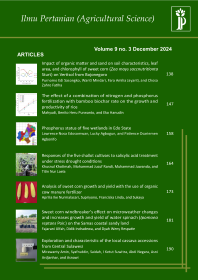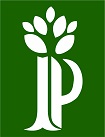Seed germination and growth of Joseph’s coat (Amaranthus tricolor L.) following exposure with Naphthalene-1-Acetic Acid (NAA) and 2,4-Dichlorophenoxyacetic Acid (2,4-D)
Hadyan Pratama Lutfi Ilmam(1*), Kumala Dewi(2)
(1) Faculty of Biology, Universitas Gadjah Mada
(2) Faculty of Biology, Universitas Gadjah Mada
(*) Corresponding Author
Abstract
Amaranthaceae is a family of plants that can be used as vegetables and medicinal herbs. Amaranthus tricolor L. is commonly cultivated because it has fast growth rate and short life cycle that can be boosted by growth regulators, such as auxins. Amaranthus tricolor L. is commonly cultivated because it has a fast growth rate and short life cycle. Growth regulators, such as auxins, can boost the growing process. This research aims to study the effects of Naphthalene-1-Acetic Acid (NAA) and 2,4-Dichlorophenoxyacetic Acid (2,4-D) towards seed germination, growth of Amaranthus tricolor L., and to determine effective concentration of NAA or 2,4-D application on Amaranthus tricolor L. The methods in this research were the exogenous hormones applied to plants every two weeks with various concentrations: 0 ppm; 10 ppm; 20 ppm; 40 ppm; or 80 ppm in completely randomized design. The germination test of Amaranthus tricolor L. for 14 days; application of NAA and 2,4-D on Amaranthus tricolor L. plant for 56 days; measurement of plant height, fresh and dry weight; calculation of stomata density; measurement of chlorophyll and carotenoid content. Data analysis was conducted using one-way analysis of variance and Duncan Multiple Range Test (DMRT) with significance level at 5%. NAA treatment delays seed germination by one day compared to control, while 2,4-D treatment inhibits germination for several days with the higher concentration of 2,4-D applied, the greater inhibition of seed germination. NAA of 10 ppm increases plant height, fresh and dry weight, chlorophyll content and leaf area of Amaranthus tricolor L. Application of NAA and 2,4-D reduced stomata density and carotenoid content of Amaranthus tricolor L., with greater effects on higher concentrations of synthetic auxins. This research concluded that NAA or 2,4-D inhibits germination of Amaranthus tricolor L. seeds, NAA of 10 ppm effectively increases plant growth and chlorophyll content, but higher NAA concentrations inhibit growth. Application of 2,4-D with concentrations above 40 ppm can be lethal for Amaranthus tricolor L.
Keywords
References
Agehara, S., Pride, L., Gallardo, M. and Hernandez-Monterroza, J. (2020). A Simple, Inexpensive, and Portable Image-Based Technique for Nondestructive Leaf Area Measurements. EDIS, 2020 (6). [Online]. Available at: doi:10.32473/edis-hs1395-2020 [Accessed 14 August 2023].
Ahammed, G. J. (2020). Role of ethylene crosstalk in seed germination and early seedling development_ A review. Plant Physiology and Biochemistry, p.8.
Arnon, D. I. (1949). Copper Enzymes in Isolated Chloroplasts. Polyphenoloxidase in Beta vulgaris. Plant Physiology, 24 (1), pp.1–15. [Online]. Available at: doi:10.1104/pp.24.1.1.
Bala, V. C., Avid, M., Kumar, P. and Singh, S. (2019). A Review on Amaranthus Tricolor as a Traditional Medicinal Plant. World Journal of Pharmaceutical Research, 8 (11), p.13.
Balcerowicz, M. and Hoecker, U. (2014). Auxin – a novel regulator of stomata differentiation. Trends in Plant Science, 19 (12), pp.747–749. [Online]. Available at: doi:10.1016/j.tplants.2014.10.006.
Butova, V. V., Bauer, T. V., Polyakov, V. A. and Minkina, T. M. (2023). Advances in nanoparticle and organic formulations for prolonged controlled release of auxins. Plant Physiology and Biochemistry, 201, p.107808. [Online]. Available at: doi:10.1016/j.plaphy.2023.107808.
Campanoni, P. and Nick, P. (2005). Auxin-Dependent Cell Division and Cell Elongation. 1-Naphthaleneacetic Acid and 2,4-Dichlorophenoxyacetic Acid Activate Different Pathways. Plant Physiology, 137 (3), pp.939–948. [Online]. Available at: doi:10.1104/pp.104.053843.
Dayan, F. E. and Zaccaro, M. L. de M. (2012). Chlorophyll fluorescence as a marker for herbicide mechanisms of action. Pesticide Biochemistry and Physiology, 102 (3), pp.189–197. [Online]. Available at: doi:10.1016/j.pestbp.2012.01.005.
Dubois, M., Van den Broeck, L. and Inzé, D. (2018). The Pivotal Role of Ethylene in Plant Growth. Trends in Plant Science, 23 (4), pp.311–323. [Online]. Available at: doi:10.1016/j.tplants.2018.01.003.
Flasiński, M. and Hąc-Wydro, K. (2014). Natural vs synthetic auxin: Studies on the interactions between plant hormones and biological membrane lipids. Environmental Research, 133, pp.123–134. [Online]. Available at: doi:10.1016/j.envres.2014.05.019.
Gil, C. S., Jung, H. Y., Lee, C. and Eom, S. H. (2020). Blue light and NAA treatment significantly improve rooting on single leaf-bud cutting of Chrysanthemum via upregulated rooting-related genes. Scientia Horticulturae, 274, p.109650. [Online]. Available at: doi:10.1016/j.scienta.2020.109650.
Hendry, G. A. F. and Grime, J. P. (1993). Stress indicators: chlorophylls and carotenoids. In: Methods in Comparative Plant Ecology: A Laboratory Manual. 1st ed. Dordrecht : Springer. pp.48–152.
Hermanns, A. S., Zhou, X., Xu, Q., Tadmor, Y. and Li, L. (2020). Carotenoid Pigment Accumulation in Horticultural Plants. Horticultural Plant Journal, 6 (6), pp.343–360. [Online]. Available at: doi:10.1016/j.hpj.2020.10.002.
Islam, F., Wang, J., Farooq, M. A., Khan, M. S. S., Xu, L., Zhu, J., Zhao, M., Muños, S., Li, Q. X. and Zhou, W. (2018). Potential impact of the herbicide 2,4-dichlorophenoxyacetic acid on human and ecosystems. Environment International, 111, pp.332–351. [Online]. Available at: doi:10.1016/j.envint.2017.10.020.
Jahan, F., Bhuiyan, M. N. H., Islam, Md. J., Ahmed, S., Hasan, Md. S., Bashera, M. A., Waliullah, Md., Chowdhury, A. N., Islam, Md. B., Saha, B. K., et al. (2022). Amaranthus tricolor (red amaranth), an indigenous source of nutrients, minerals, amino acids, phytochemicals, and assessment of its antibacterial activity. Journal of Agriculture and Food Research, 10, p.100419. [Online]. Available at: doi:10.1016/j.jafr.2022.100419.
Peterson, M. A., McMaster, S. A., Riechers, D. E., Skelton, J. and Stahlman, P. W. (2016). 2,4-D Past, Present, and Future: A Review. Weed Technology, 30 (2), pp.303–345. [Online]. Available at: doi:10.1614/WT-D-15-00131.1.
Poole, I. and Kürschner, W. M. (1999). Stomatal density and index: The practice. In: Fossil Plants and Spores: modern techniques. London : The Geological Society London. pp.257–260.
Proctor, M. H. (1963). Some steps in the degradation of naphthalene acetic acid. Plant and Soil, 18 (3), pp.338–345. [Online]. Available at: doi:10.1007/BF01347233.
Rastogi, A. and Shukla, S. (2013). Amaranth: A New Millennium Crop of Nutraceutical Values. Critical Reviews in Food Science and Nutrition, 53 (2), pp.109–125. [Online]. Available at: doi:10.1080/10408398.2010.517876.
Sarker, U. and Oba, S. (2019). Protein, dietary fiber, minerals, antioxidant pigments and phytochemicals, and antioxidant activity in selected red morph Amaranthus leafy vegetable. Elfalleh, W. (Ed). PLOS ONE, 14 (12), p.e0222517. [Online]. Available at: doi:10.1371/journal.pone.0222517.
Shuai, H., Meng, Y., Luo, X., Chen, F., Zhou, W., Dai, Y., Qi, Y., Du, J., Yang, F., Liu, J., et al. (2017). Exogenous auxin represses soybean seed germination through decreasing the gibberellin/abscisic acid (GA/ABA) ratio. Scientific Reports, 7 (1), Nature Publishing Group., p.12620. [Online]. Available at: doi:10.1038/s41598-017-13093-w.
Sybilska, E. and Daszkowska-Golec, A. (2023). A complex signaling trio in seed germination: Auxin-JA-ABA. Trends in Plant Science, 28 (8), pp.873–875. [Online]. Available at: doi:10.1016/j.tplants.2023.05.003.
Todd, O. E., Figueiredo, M. R. A., Morran, S., Soni, N., Preston, C., Kubeš, M. F., Napier, R. and Gaines, T. A. (2020). Synthetic auxin herbicides: finding the lock and key to weed resistance. Plant Science, 300, p.110631. [Online]. Available at: doi:10.1016/j.plantsci.2020.110631.
Uddin, M., Chishti, A. S., Singh, S., Bhat, U. H., Singh, S. and Khan, M. M. A. (2023). Effect of GA3 and NAA on growth, physiological parameters, and bioactive constituents of Ammi majus L. Industrial Crops and Products, 194, p.116328. [Online]. Available at: doi:10.1016/j.indcrop.2023.116328.
Urry, L. A., Cain, M. L., Wasserman, S. A., Minorsky, P. V. and Reece, J. B. (2016). Campbell Biology. 11th ed. New York : Pearson Education.
Wu, M., Wu, J. and Gan, Y. (2020). The new insight of auxin functions: transition from seed dormancy to germination and floral opening in plants. Plant Growth Regulation, 91 (2), pp.169–174. [Online]. Available at: doi:10.1007/s10725-020-00608-1.
Zuanazzi, N. R., Ghisi, N. D. C. and Oliveira, E. C. (2020). Analysis of global trends and gaps for studies about 2,4-D herbicide toxicity: A scientometric review. Chemosphere, 241, p.125016. [Online]. Available at: doi:10.1016/j.chemosphere.2019.125016.
Article Metrics
Refbacks
- There are currently no refbacks.
Ilmu Pertanian (Agricultural Science) ISSN 0126-4214 (print), ISSN 2527-7162 (online) is published by Faculty of Agriculture Universitas Gadjah Mada collaboration with Perhimpunan Sarjana Pertanian Indonesia (PISPI) and licensed under a Creative Commons Attribution-ShareAlike 4.0 International License.














